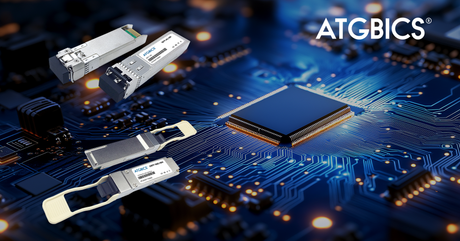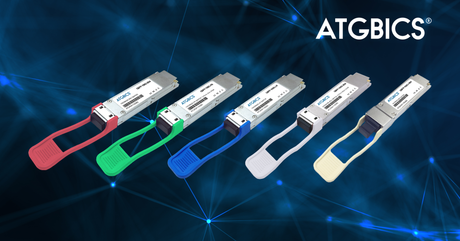400G transceivers are high speed optical modules designed for 400Gbps data transmission. They are commonly used in data centres, cloud computing, high performance computing (HPC) and AI environments. These transceivers come in three main form-factors: Octal Small Form-factor Pluggable (OSFP), Quad Small Form-factor Pluggable 112 (QSFP112) and Quad Small Form-factor Pluggable – Double Density (QSFP-DD). While these provide the same data rate, there are some key differences to consider.
OSFP![]()

- Larger footprint – refer to our knowledge base for further details
- Built in heat dissipation technology
- Maximum power consumption typically <15W
- QSFP compatible with an adaptor
- Eight lanes running at 50Gbps each
- Developed alongside 400G technology
- Finned top, Flat top and Closed top options
- Connectors – Duplex LC, MPO-12, MPO-16
- Suitable for 800G and beyond
- OSFP MSA Specification
QSFP-DD
- Smaller footprint – refer to our knowledge base for further details
- Heat dissipation technology is dependent on external hardware
- Maximum power consumption typically <12W
- Backwards compatible with other QSFP equipment such as QSFP56/QSFP28 (used in 200G and 100G)
- Eight lanes running at 50Gbps each
- Connectors – Duplex LC, MPO-12, MPO-16
- Suitable for 800G and 1.6T
- QSFP-DD MSA Specification
QSFP112
- Smaller footprint – refer to our knowledge base for further details
- Heat dissipation technology is dependent on external hardware
- Maximum power consumption typically <10W
- Backwards compatible with other QSFP equipment such as QSFP56/QSFP28 (used in 200G and 100G)
- Four lanes targeting 112Gbps each
- Connectors - Duplex LC, MPO-12
- Not suitable for 800G
- QSFP112 MSA Specification
QSFP-DD and QSFP112 transceivers are ideal for existing infrastructures that still rely on older QSFP technologies, as they can be seamlessly integrated without requiring significant hardware changes. OSFP transceivers on the other hand are not backwards compatible with previous technologies without an adaptor, due to their differing physical size and so are better suited to newer systems. As they were developed with 400G data rates, they offer a future-proof solution for emerging technologies like 800G and the eventual transition to 1.6T and beyond.
OSFP Types
- Finned top – Heat sink made up of thin extended fins is attached to the top of the module, increasing the surface area and pulling heat away from the module.
- Flat top/Riding Heat Sink (RHS) – Developed by NVIDIA® for use in Network Interface Cards (NICs). There is no heat sink on the transceiver itself; instead, a riding heat sink is integrated in the OSFP module cage.
- Closed top – Similar to finned top, but with an additional metal cover over the fins. This enhances heat dissipation by increasing airflow along the entire transceiver and enabling better heat conduction from the fins.
See the OSFP MSA Rev 1.0 for more information.

Modulation Types
400G transceivers utilise advanced modulation techniques to efficiently handle high speed data transmission. This technology typically uses PAM4 (Pulse Amplitude Modulation 4-Level) or coherent modulation types such as QPSK, 8-QAM or 16-QAM. Unlike PAM4, which relies solely on amplitude variations, coherent modulation uses multiple properties of light (phase, amplitude, and polarisation), allowing for significantly extended transmission density and distances. These modulation types enable high speed data transmission over hundreds or even thousands of kilometres and are common in ZR and ZR+ transceivers. Find out more about coherent technology here.
Optical Standards
|
Standard |
Form Factor |
Maximum Reach |
Wavelength |
Media |
|
VR |
QSFP112 |
30m (OM3), 50m (OM4/5) |
850nm |
MMF |
|
SR |
QSFP112 |
60m (OM3), 100m (OM4/5) |
850nm |
MMF |
|
DR |
QSFP112 |
500m |
1310nm |
SMF |
|
FR |
QSFP112 |
2km |
1310nm |
SMF |
|
LR |
QSFP112 |
10km |
1310nm |
SMF |
|
ER |
QSFP112 |
40km |
1310nm |
SMF |
|
ZR |
QSFP112 |
80km |
1550nm |
SMF |
|
SR4 |
QSFP112 |
50m |
850nm |
MMF |
|
SR4.2 |
OSFP/QSFP-DD |
150m |
850nm / 910nm |
MMF |
|
SR8 |
OSFP/QSFP-DD |
100m |
850nm |
MMF |
|
DR4 |
OSFP/QSFP-DD/QSFP112 |
500m |
1310nm |
SMF |
|
XDR4/DR4+ |
OSFP/QSFP-DD/QSFP112 |
2km |
1310nm |
SMF |
|
FR4 |
OSFP/QSFP-DD/QSFP112 |
2km |
1271nm, 1291nm, 1311nm, 1331nm |
SMF |
|
2FR4 |
OSFP |
2km |
1271nm, 1291nm, 1311nm, 1331nm |
SMF |
|
FR8 |
OSFP/QSFP-DD |
2km |
1271nm, 1291nm, 1311nm, 1331nm |
SMF |
|
LR4 |
OSFP/QSFP-DD/QSFP112 |
10km |
1271nm, 1291nm, 1311nm, 1331nm |
SMF |
|
LR8 |
OSFP/QSFP-DD |
10km |
1273.54nm, 1277.89nm, 1282.26nm, |
SMF |
|
ER4 |
QSFP-DD |
40km |
1295.56nm, 1300.05nm, 1304.58nm, 1309.14nm |
SMF |
|
ER8 |
OSFP/QSFP-DD |
40km |
1273.54nm, 1277.89nm, 1282.26nm, |
SMF |
|
ZR |
OSFP/QSFP-DD |
80km (120km amplified) |
DWDM Tunable 1528.38~1568.77nm |
SMF |
|
ZR+ |
OSFP/QSFP-DD |
>120km |
DWDM Tunable 1528.38~1568.77nm |
SMF |
Below are some technical images taken from the relevant MSA documents demonstrating how these form factors work in 400G applications:

400G DR4 Block Diagram from OSFP MSA

400G SR8 Block Diagram from OSFP MSA

400G FR4 Block Diagram from OSFP MSA

400G FR8/LR8 Block Diagram from OSFP MSA

QSFP-DD Application Reference Model from QSFP-DD MSA

QSFP112 Application Reference Model from QSFP112 MSA
See our knowledge base article to find out more about optical standards for lower data rates.
Benefits of 400G
The high bandwidth capacity of 400G transceivers enables them to meet the growing demands of modern technologies, particularly with the rapid expansion of AI across various industries. These modules have both lower power consumption and reduced cost per bit of data transferred compared to previous technology, making them an efficient solution for existing data intensive environments as well as future developments. Additionally, their scalability makes them ideal for a wide range of applications. With OSFP form-factor support, 400G technology is well prepared for future advancements of speeds up to 1.6Tbps and beyond.
400G Applications
- Data centres
- AI and machine learning workloads
- Backbone infrastructure for 5G networks
- Cloud computing
- Enterprise networks
- Metro and long haul telecommunications
- Financial market networks
ATGBICS offers a comprehensive range of 400G transceivers, DACs and AOCs in OSFP, QSFP-DD and QSFP112 form-factors, ensuring the right fit for any application.
















